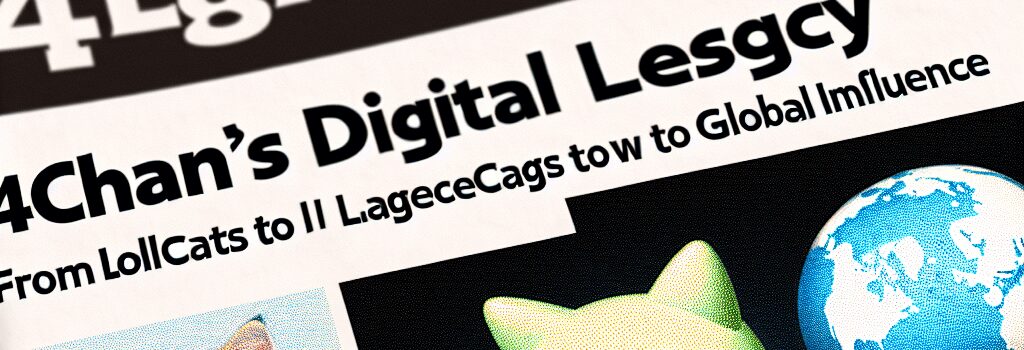4chan’s Digital Legacy: From LOLcats to Global Influence

What began as a late‑night playground for LOLcat enthusiasts evolved into one of the Internet’s most notorious digital ecosystems. Though 4chan was wiped from the web in April 2025 by a rival board’s hacking operation, its toxic legacy lives on. This article expands on the site’s technical underpinnings, security posture, cultural impact, and how its DNA persists in today’s platforms.
1. From Ephemeral Image Board to Culture Factory
Launched in 2003 by Christopher “Moot” Poole, 4chan was modeled on Japan’s Futaba Channel (2chan). Built on a LAMP stack (Linux, Apache, MySQL, PHP), it featured:
- Anonymous posting—no user accounts or persistent IDs.
- Time‑limited threads—boards auto‐expire after periods of inactivity (404 timeouts).
- Specialized “/boards/”—over 70 subforums including /b/ (random), /pol/ (politically incorrect), /v/ (video games), /ck/ (cooking), /cm/ (comics), and adult boards.
- Minimal moderation—reliance on community flagging and simple CAPTCHA systems (GD‑based image challenges) for spam prevention.
This lightweight, minimal‑friction architecture enabled a rapid viral loop: users who posted shocking, subversive, or satirical content gained instant visibility—provided someone preserved their posts via screenshots or external archives like 4archive.
2. Technical Specifications & Security Posture
Behind the scenes, 4chan operated a set of bespoke PHP scripts and memcached servers to handle millions of requests per hour. Key elements of its security and infrastructure included:
- Load‑balanced Apache clusters with Nginx as a reverse proxy for static image delivery.
- Redis for ephemeral thread storage, enabling immediate thread expiration without manual cleanup.
- Basic anti‐DDoS measures—Cloudflare in front lines after 2016, though its protection was often disabled during high‐profile raids.
- Vulnerability profile—common exposures included Local File Inclusion (LFI) and Cross‐Site Scripting (XSS), which threat actors exploited to dox users or inject malicious payloads.
Security researcher Dr. Alice Nguyen of CyberSafe Labs notes, “4chan’s minimal security hygiene was both a feature and a bug: the very ephemerality that attracted users also invited relentless probing by malicious actors.”
3. The Dark Side Emerges: Harassment, Doxing, and Extremism
By the late 2000s, militantly anonymous pranks gave way to organized harassment campaigns. The site incubated doxing tools and distributed lists of private data, culminating in campaigns such as:
- Operation Chanology (2008)—anti-Scientology protests coordinated on /b/.
- Gamergate (2014)—a harassment movement targeting women in gaming, amplifying misogynistic rhetoric across platforms.
- Mass shooter manifestos—shared and celebrated on /pol/, contributing to real‑world violence.
Journalist Ryan Broderick’s personal account of being doxed and phone‑bombed demonstrates how the site’s tools combined image threads with off‑site telephony APIs to generate dozens of harassment calls in minutes.
4. Influence on Mainstream Platforms
4chan’s cultural and ideological currents soon tidal‑waved into Twitter, Facebook, and Reddit. Anonymous memes metamorphosed into branded hashtags, while Reactionary bots leveraged platform APIs to automate disinformation campaigns:
- Twitter’s API v1.1 bot ecosystems (2012–2022) mirrored /pol/ style raids, pushing far‑right narratives.
- Facebook Graph API manipulations—use of scraped 4chan usernames and image hashes to seed hyperpolarized ad targeting.
- YouTube algorithm gaming—leveraging rapid, anonymous accounts to upvote extremist content, tricking recommendation engines.
Ben Collins, former extremism reporter for The Onion, observes, “Once the fringe becomes mainstream policy, the original shock site loses its raison d’être. Elon Musk’s Twitter acquisition in 2022 was the final blow—hate speech under real names, monetized by blue checkmarks, was effectively 4chan without the cloak.”
5. Legacy in the Era of Cloud and Decentralization
With 4chan offline, emergent platforms aim to recapture its ethos—some using IPFS (InterPlanetary File System) for content permanence, others adopting blockchain‑based identity for pseudonymity:
- MemeChain: Ethereum‑hosted image posting with NFT validation.
- Decentraboard: A Go‑Lang, gRPC‑based forum mirroring 4chan’s ephemerality, running atop Kubernetes clusters for auto‑scaling.
- Signal/Matrix bridges—private rooms that use end‑to‑end encryption to exchange ephemeral media, circumventing centralized moderation.
Dr. Lars Hoffman, co-creator of Decentraboard, says, “We’re rebuilding the ‘wild west’ experience with containerized microservices and zero‑trust networking. But we’re also adding rate‑limiting and federated moderation to avoid 4chan’s descent into chaos.”
6. Deep Dive: Cultural Persistence and Archival Challenges
Though offline, 4chan’s content persists via a complex network of archives:
- 4archive and warosu.org—mirror static HTML costs on S3 buckets with CloudFront CDN.
- r/4chanMuseum on Reddit—crowdsourced threads reposted with Reddit’s caching mechanisms.
- Tor hidden services—some keep private caches, accessible only via .onion addresses, circumventing DMCA takedown efforts.
Content archivist Maya Patel warns, “Without a central log, reconstructing the true scope of 4chan’s conversations is impossible. We’re left with stochastic snapshots, each representing a fraction of the site’s cultural output.”
7. The Future of Anonymous Communities
As mainstream socials standardize content recommendations with AI‑driven feeds, the question remains: will a new anonymous forum ever capture 4chan’s raw energy? Key trends to watch:
- AI‑moderated anonymity—ML models that flag hate speech without revealing user data.
- Edge computing message boards—hosting threads on user devices (P2P gossip protocols), reducing server‑side control.
- Quantum‑resistant encryption for ephemeral messaging—ensuring that deleted threads cannot be reconstructed.
Security strategist Bruce Schneier comments, “Anonymous spaces are necessary for some forms of free expression, but without accountability, they become toxic. The future lies in technical safeguards that allow privacy and safety to coexist.”
Conclusion
4chan’s shutdown marks the end of an era but also underscores how its core innovations—anonymity, ephemerality, and minimal moderation—have been absorbed into our digital mainstream. From cloud‑native infographic memes to startup‑driven decentralized forums, the battle between open expression and platform governance continues. Understanding the technical and cultural lessons of 4chan is essential for architects building the next generation of online communities.